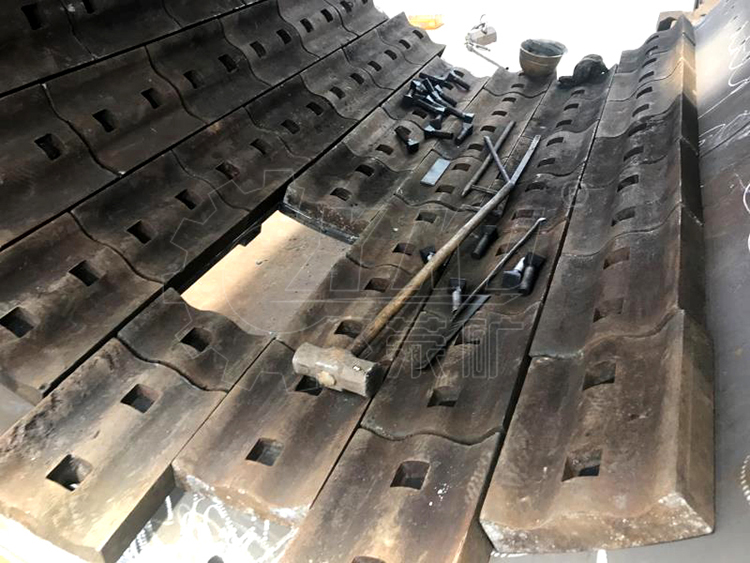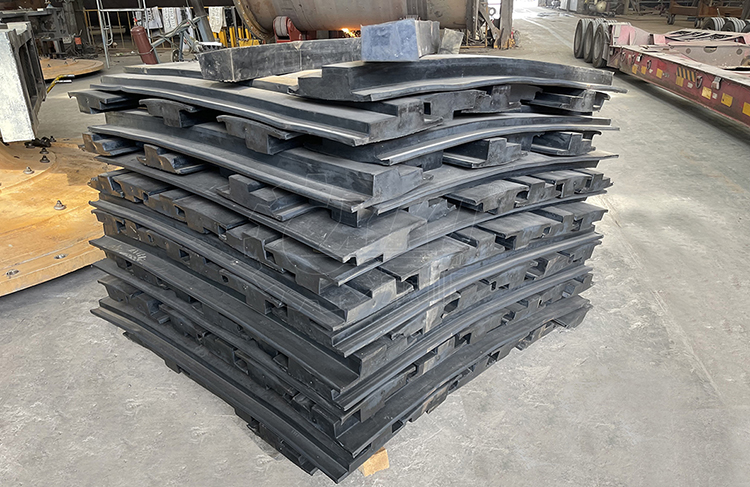Product FAQ
What are the types of liners for wet ball mills?
The wet ball mill liner refers to the partition inlaid on the wall of the ball mill cylinder. It separates the cylinder from the material and the steel ball, which plays a good protective role on the liner. Of course, in addition to protecting the cylinder, the wet ball mill liner has other functions.

The role of the liner of the wet ball mill
1. Protect the cylinder
The outstanding role of the liner of the wet ball mill is to protect the cylinder body from being hit by materials and steel balls during operation, thereby extending the service life of the cylinder body.You must know that as a large-scale mining equipment, ball mills have a higher price, large investment costs and inconvenient maintenance, while the price of the liner is only about 2%-3% of the price of the whole ball mill, and it is easy to replace.Secondly, the liner can enhance the stiffness of the cylinder body and effectively avoid premature deformation of the cylinder body.When the liner is closely connected to the cylinder of the ball mill, the structural strength of the cylinder is greatly improved.
2. It has a lifting effect on materials and steel balls
The liner of the wet ball mill enhances the material and steel ball.Due to the different shapes of the liners, such as waveforms, stepped shapes, etc., when the cylinder rotates, with the help of the shape and friction of the liners, energy can be transmitted to the material and the steel ball, giving them a certain position energy and throwing kinetic energy, so that they produce an “arc-parabola” trajectory that meets the requirements of the grinding process, thereby impacting and grinding the material.
3. It has a grading effect on steel balls
Part of the liner also has a grading effect on the steel ball.The automatic grading liner can concentrate the larger diameter steel balls at the feed end of the ball mill cylinder for crushing large pieces of material, and the smaller diameter steel balls at the discharge end for crushing smaller materials.In short, these functions of the liner of the wet ball mill are essential for the efficient and stable operation of the ball mill.
Types and characteristics of wet ball mill liners
1. Rubber liner
Rubber liners are one of the widely used liners in wet ball mills.It has many advantages, such as high pressure resistance, good elasticity, can effectively absorb impact energy, reduce wear, and greatly extend service life.Its long life and low price characteristics make it more advantageous in various types of wet ball mills, especially for large and medium-sized ball mills.At the same time, the rubber liner can also reduce the noise of equipment operation, which is conducive to improving the working environment.However, the rubber liner also has some disadvantages. It is not suitable for dry grinding, is not high temperature resistant, has poor impact resistance, and is not suitable for use in rough grinding silos of ball mills.

2. High aluminum ceramic liner
The main component of high-alumina ceramic liners is alumina, which has good wear resistance, impact resistance and corrosion resistance.High-alumina ceramic liners can effectively resist the impact and wear of abrasive particles on the inner wall, and are widely used in the inner wall liners of ball mills, which improves the service life of ball mills.The hardness of common wear-resistant high-alumina ceramic liners can reach 9 Mohs hardness, which is close to the hardness of diamonds, and can effectively resist various wear and shocks.In addition, the high-alumina ceramic liner also has excellent corrosion resistance and can resist the erosion of a variety of strong acids, alkalis and salts.It also has the characteristics of high temperature resistance and still maintains good physical and chemical properties in high temperature environments.
3. Silicon carbide ceramic liner
Silicon carbide ceramic liners have high hardness, high wear resistance and excellent heat conduction properties.Silicon carbide ceramics have the characteristics of super hard, high temperature resistance, high thermal conductivity and mechanical strength, low coefficient of thermal expansion, excellent thermal stability, low density, high specific stiffness, and non-magnetism.It is suitable for high-speed ball mills and occasions with high requirements for abrasive particles, and can improve the work efficiency and product quality of ball mills.At present, silicon carbide ceramics are used in various industries such as aviation, aerospace, and nuclear industry, such as silicon carbide ceramic mirrors, ceramic components for high-end equipment such as IC integrated circuit manufacturing, heat exchangers under extreme conditions, and bulletproof materials.
4. Zirconia ceramic liner
Zirconia ceramic liners have high hardness, wear resistance and corrosion resistance, as well as good thermal conductivity and insulation properties.Zirconia ceramic liners are suitable for handling abrasives with high hardness, high abrasion resistance and high viscosity, which can effectively extend the service life of the ball mill.Its high hardness and good wear resistance can effectively resist the impact and wear of abrasives and protect the inner wall of the ball mill.Its good thermal conductivity and insulation properties enable it to better transfer heat and improve the efficiency of ball milling during the operation of the ball mill.

5. High manganese steel liner
The high manganese steel liner has a certain impact toughness. When it is hit, the surface will be hardened by cold work, which is hard and wear-resistant. The hardness can reach HB300-350, and the impact value can reach 700Nm/cm2.High manganese steel liners are commonly used in the first silo of ball mills-the crushing silo.The material particle size of the crushing silo is large, and the grinding body is required to be mainly affected by impact, and the grinding body should be thrown off. Therefore, the inner lining plate of the crushing silo must have a high lifting capacity and good impact resistance to the grinding body. The high manganese steel liner is the best choice to meet this requirement.However, the high-manganese steel liner is prone to premature anti-convex bending and deformation during use, and the fixing bolts are pulled off, causing the liner to fall off and the life span is reduced. According to statistics, the life span of the high-manganese steel liner is about 5000-6000 hours.
6. High chromium cast iron liner
High chromium cast iron liner has excellent wear resistance and high temperature plasticity, high hardness, small hardness gradient, high tempering stability and corrosion resistance.Compared with other wear-resistant materials, it has high hardness and superior abrasive wear resistance, especially under low load impact.However, the impact toughness of high-chromium cast iron liners is poor, and due to the high molybdenum content, the price is expensive, and the application is limited.At present, many institutions are committed to improving the composition of high-chromium cast iron in order to reduce costs.
7. Medium alloy steel liner
With the continuous development of technology, medium alloy steel liners have gradually shown their advantages.Medium alloy steel liners have performed well in terms of wear resistance and impact resistance, and have gradually replaced high manganese steel liners as the mainstream trend of market development.Medium alloy steel liners have high hardness and strength, can withstand greater impact and wear, and at the same time have good toughness and processability, which are easy to manufacture and install.Its price is relatively reasonable and cost-effective, and it is favored by more and more users.
Categories
News
Contact Us
Contact: XKJ GROUP
Phone: 0086 138 3714 0277
Tel: 0371-65751333
E-mail: sales01@xkjgroup.com
Add: Xing yang city, Zheng zhou city, Henan province, China